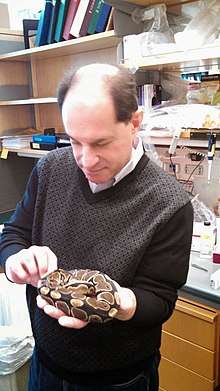David Julius
David J. Julius (born November 4, 1955) is an American physiologist known for his work on molecular mechanisms underlying detection of thermal stimuli and natural products. He is a professor at the University of California, San Francisco, and won the 2010 Shaw Prize in life science and medicine.[2]
David Julius | |
|---|---|
 | |
| Born | November 4, 1955 Brighton Beach, Brooklyn, New York |
| Nationality | American |
| Alma mater | Massachusetts Institute of Technology University of California, Berkeley |
| Known for | Cloning of ionotropic serotonergic receptors; discovery of noxious hot, cold, and irritant receptors |
| Scientific career | |
| Fields | Physiology Biochemistry Neuroscience |
| Institutions | University of California, San Francisco |
| Doctoral advisor | Jeremy Thorner Randy Schekman |
| Other academic advisors | Richard Axel[1]
Alexander Rich |
Education
A native of Brighton Beach, Julius earned his undergraduate degree from Massachusetts Institute of Technology in 1977. He attained his doctorate from University of California, Berkeley in 1984, under joint supervision of Jeremy Thorner and Randy Schekman.[3] In 1989, he completed his post-doctoral training with Richard Axel at Columbia University where he cloned and characterized the serotonin 1c receptor.[4]
Research career
In 1997, the Julius lab cloned and characterized TrpV1 which is the receptor that detects capsaicin, the chemical in chili peppers that makes them "hot".[5] Remarkably, they found that TrpV1 also detects noxious heat.[5][6] TrpV1 is part of the large family of structurally related TRP (transient receptor potential) cation channels. Animals that lack TrpV1 (using genetic knockouts of the protein) lose sensitivity to noxious heat and capsaicin.[7]
The Julius lab has also cloned and characterized TrpM8 (CMR1) and TrpA1, both members of the TRP superfamily. They demonstrated that TrpM8 detects menthol and cooler temperatures[8][9] and TrpA1 detects mustard oil (allyl isothiocyanate).[10] These observations suggested that TRP channels could detect a range of temperatures and chemicals. David Julius's lab has also made important contributions to the study of nociception by discovering toxins that modulate these channels,[11] describing unique adaptations of the channels in diverse species[12] and solving the cryo-EM structures of numerous channels.[13][14]
Awards
In 2000, Julius was awarded the inaugural Perl-UNC Neuroscience Prize for his work on cloning the capsaicin receptor. In 2010, he won the Shaw Prize for his work identifying the ion channels involved in various aspects of nociception. In 2014 he was honored by Johnson & Johnson with the Dr. Paul Janssen Award for Biomedical Research for discovering the molecular basis for pain and thermosensation. In 2017, he won the Gairdner Foundation International Award[15] and the HFSP Nakasone Award.[16] He has been awarded the 2020 Breakthrough Prize in Life Sciences, [17] and the 2020 Kavli Prize in neuroscience (together with Ardem Patapoutian).[18]
References
- "Julius Lab at UCSF Mission Bay | David Julius Lab".
- "Julius Named to Receive the Shaw Prize". ucsf.edu. Retrieved 5 December 2016.
- "David Julius, PhD 49th Faculty Research Lecture Award". senate.ucsf.edu. Retrieved 5 December 2016.
- Julius, D.; MacDermott, A. B.; Axel, R.; Jessell, T. M. (1988-07-29). "Molecular characterization of a functional cDNA encoding the serotonin 1c receptor". Science. 241 (4865): 558–564. Bibcode:1988Sci...241..558J. doi:10.1126/science.3399891. ISSN 0036-8075. PMID 3399891.
- Caterina, M. J.; Schumacher, M. A.; Tominaga, M.; Rosen, T. A.; Levine, J. D.; Julius, D. (1997-10-23). "The capsaicin receptor: a heat-activated ion channel in the pain pathway". Nature. 389 (6653): 816–824. Bibcode:1997Natur.389..816C. doi:10.1038/39807. ISSN 0028-0836. PMID 9349813.
- Tominaga, M.; Caterina, M. J.; Malmberg, A. B.; Rosen, T. A.; Gilbert, H.; Skinner, K.; Raumann, B. E.; Basbaum, A. I.; Julius, D. (September 1998). "The cloned capsaicin receptor integrates multiple pain-producing stimuli". Neuron. 21 (3): 531–543. doi:10.1016/S0896-6273(00)80564-4. ISSN 0896-6273. PMID 9768840.
- Caterina, M. J.; Leffler, A.; Malmberg, A. B.; Martin, W. J.; Trafton, J.; Petersen-Zeitz, K. R.; Koltzenburg, M.; Basbaum, A. I.; Julius, D. (2000-04-14). "Impaired nociception and pain sensation in mice lacking the capsaicin receptor". Science. 288 (5464): 306–313. Bibcode:2000Sci...288..306C. doi:10.1126/science.288.5464.306. ISSN 0036-8075. PMID 10764638.
- McKemy, David D.; Neuhausser, Werner M.; Julius, David (2002-03-07). "Identification of a cold receptor reveals a general role for TRP channels in thermosensation". Nature. 416 (6876): 52–58. Bibcode:2002Natur.416...52M. doi:10.1038/nature719. ISSN 0028-0836. PMID 11882888.
- Bautista, Diana M.; Siemens, Jan; Glazer, Joshua M.; Tsuruda, Pamela R.; Basbaum, Allan I.; Stucky, Cheryl L.; Jordt, Sven-Eric; Julius, David (2007-07-12). "The menthol receptor TRPM8 is the principal detector of environmental cold". Nature. 448 (7150): 204–208. Bibcode:2007Natur.448..204B. doi:10.1038/nature05910. ISSN 1476-4687. PMID 17538622.
- Jordt, Sven-Eric; Bautista, Diana M.; Chuang, Huai-Hu; McKemy, David D.; Zygmunt, Peter M.; Högestätt, Edward D.; Meng, Ian D.; Julius, David (2004-01-15). "Mustard oils and cannabinoids excite sensory nerve fibres through the TRP channel ANKTM1". Nature. 427 (6971): 260–265. Bibcode:2004Natur.427..260J. doi:10.1038/nature02282. ISSN 1476-4687. PMID 14712238.
- Bohlen, Christopher J.; Chesler, Alexander T.; Sharif-Naeini, Reza; Medzihradszky, Katalin F.; Zhou, Sharleen; King, David; Sánchez, Elda E.; Burlingame, Alma L.; Basbaum, Allan I. (2011-11-16). "A heteromeric Texas coral snake toxin targets acid-sensing ion channels to produce pain". Nature. 479 (7373): 410–414. Bibcode:2011Natur.479..410B. doi:10.1038/nature10607. ISSN 1476-4687. PMC 3226747. PMID 22094702.
- Gracheva, Elena O.; Ingolia, Nicholas T.; Kelly, Yvonne M.; Cordero-Morales, Julio F.; Hollopeter, Gunther; Chesler, Alexander T.; Sánchez, Elda E.; Perez, John C.; Weissman, Jonathan S. (2010-04-15). "Molecular basis of infrared detection by snakes". Nature. 464 (7291): 1006–1011. Bibcode:2010Natur.464.1006G. doi:10.1038/nature08943. ISSN 1476-4687. PMC 2855400. PMID 20228791.
- Liao, Maofu; Cao, Erhu; Julius, David; Cheng, Yifan (2013-12-05). "Structure of the TRPV1 ion channel determined by electron cryo-microscopy". Nature. 504 (7478): 107–112. Bibcode:2013Natur.504..107L. doi:10.1038/nature12822. ISSN 1476-4687. PMC 4078027. PMID 24305160.
- Cao, Erhu; Liao, Maofu; Cheng, Yifan; Julius, David (2013-12-05). "TRPV1 structures in distinct conformations reveal activation mechanisms". Nature. 504 (7478): 113–118. Bibcode:2013Natur.504..113C. doi:10.1038/nature12823. ISSN 1476-4687. PMC 4023639. PMID 24305161.
- "David Julius - Gairdner Foundation". Gairdner Foundation. Retrieved 2018-11-01.
- "The 2017 HFSP Nakasone Award goes to David Julius | Human Frontier Science Program". www.hfsp.org. Retrieved 2018-11-09.
- Breakthrough Prize in Life Sciences 2020
- 2020 Kavli Prize in Neuroscience www.kavliprize.org. Retrieved 2020-27-05.
